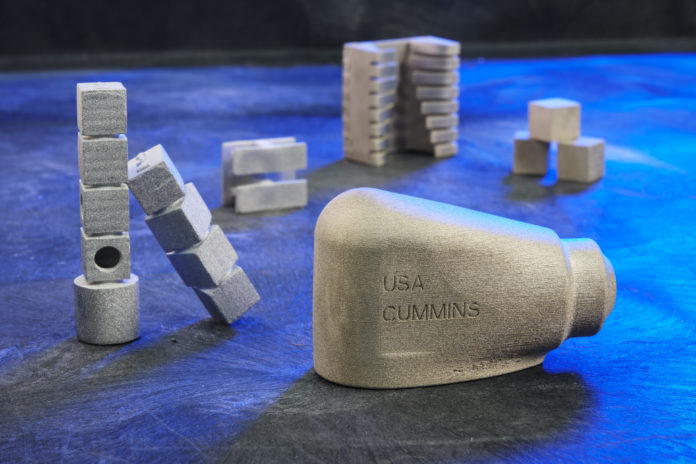In the additive manufacturing industry, we mostly hear about partnerships and rarely about applications, which in my opinion are what raises people’s interest the most. So, what a pleasant surprise, when Cummins told the industry they are finalizing their first production part using binder jet 3D printing.
For those who do not know, Cummins is an organization that gathers complementary business segments that design, manufacture, distribute and service a broad portfolio of power solutions.
According to Tim Millwood, Vice President of Global Manufacturing, the completion of this part is another significant milestone in their additive manufacturing roadmap. . “We’re on the cusp of being able to leverage a broad range of additive technologies to print the parts we need, using the right technology and at lower costs and increased speeds”, he said.
So, what is this part?
We are talking about a Cummins Emission Solutions (CES) lance tip adapter, the type of part that is being utilized in high horsepower engines. The pivotal emissions component can atomize and inject diesel exhaust fluid into the engine exhaust stream in order to bring down the amount of nitrogen oxides (NOx) emitted from Cummins’ engine systems.
In the list of advantages listed after using AM, three distinguish themselves from others: a lighter-weight design, improved geometry for fluid and airflow, and the elimination of the added complexity of cross-drillings.
The truth is, the manufacturing process, ideal for high-volume production, also enables an environmental-friendly production. Cummins explains in a press communication that the binder jet printer can take nearly 100% of the leftover powder from the printed part, recirculate it through the system and reuse it in the production of other parts. That’s a big advantage for an industry that is moving towards sustainability.
If you are not familiar with the process of binder jetting itself, note that the printing process consists in a print head moving across a bed of powders to deposit a liquid binding agent where needed. One layer at a time, the liquid binding agent thereafter bonds these areas together until a solid part is created. From complex components to less complex ones, the operator would achieve 60 to 100 times faster than other laser-based printing processes.
Cummins and its additive manufacturing journey
Like all companies that seek to be on top of its business, Cummins has invested extra miles to embark on its industry 4.0 journey.
As AM is an undisputable production tool in this roadmap, the company has decided to invest in binder jet technology precisely two years ago, in April 2019. Last year, it opened an Additive Manufacturing Lab within its Manufacturing Engineering Development Center (MEDC) in Columbus, Indiana, with the goal of developing and validating the industrialized binder jet additive manufacturing process.
The Cummins teams are also familiar with sand printing technologies ideal to produce moulds for components, as well as polymer (plastic and resin) 3D printing that they have been leveraging for years and they continue to enhance their production with low-volume metal printing which is supported by three GE Additive Concept Laser M2 DMLM machines.
What I find interesting here, is that it might be one thing to decide to invest in AM technologies, but the true milestone comes when the user has effectively built up extensive experience with the technology.
And that’s what is happening here. Gaining experience and skillset in designing for additive manufacturing as the technology advances has required the Cummins AM and Engineering teams to work on several additional concept parts.
That’s a work that is still in progress as not only the current lance tip adapter is undergoing approval but the team hopes to finalize more parts this year.
To achieve their goal, the company relies on two binder jet printers, one at its Additive Manufacturing Lab in Columbus, Indiana and one at GE Additive’s Disruptive Innovation Lab near Cincinnati, Ohio, but also on its partnership with GE Additive.
Together, they are working on a third-generation binder jet technology, which will deliver an even higher throughput, improved quality and lower cost.
“This is the first of many milestones. The focus of our partnership is to productionize applications at cost, quality and needed scale. We are proud to work with Cummins to develop additive technology and provide meaningful return on investment throughout its supply chains,” said Jacob Brunsberg, Binder Jet product line leader, GE Additive.
Remember, you can post free of charge job opportunities in the AM Industry on 3D ADEPT Media or look for a job via our job board. Make sure to follow us on our social networks and subscribe to our weekly newsletter : Facebook, Twitter, LinkedIn & Instagram ! If you want to be featured in the next issue of our digital magazine or if you hear a story that needs to be heard, make sure to send it to contact@3dadept.com






